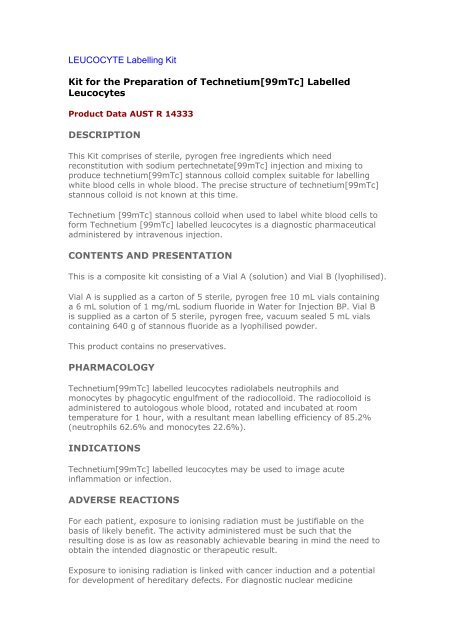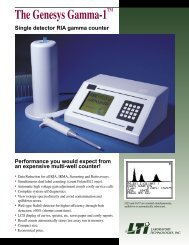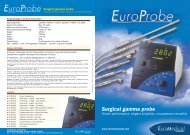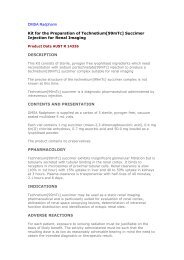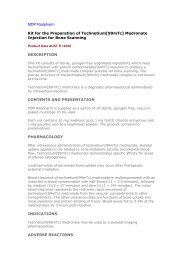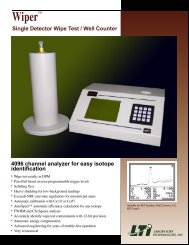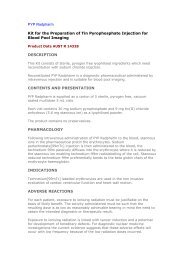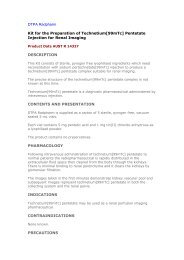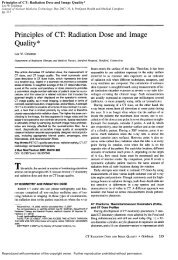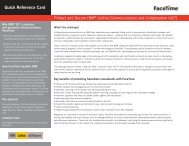LEUCOCYTE Labelling Kit Kit for the Preparation of Technetium ...
LEUCOCYTE Labelling Kit Kit for the Preparation of Technetium ...
LEUCOCYTE Labelling Kit Kit for the Preparation of Technetium ...
- No tags were found...
Create successful ePaper yourself
Turn your PDF publications into a flip-book with our unique Google optimized e-Paper software.
<strong>LEUCOCYTE</strong> <strong>Labelling</strong> <strong>Kit</strong><strong>Kit</strong> <strong>for</strong> <strong>the</strong> <strong>Preparation</strong> <strong>of</strong> <strong>Technetium</strong>[99mTc] LabelledLeucocytesProduct Data AUST R 14333DESCRIPTIONThis <strong>Kit</strong> comprises <strong>of</strong> sterile, pyrogen free ingredients which needreconstitution with sodium pertechnetate[99mTc] injection and mixing toproduce technetium[99mTc] stannous colloid complex suitable <strong>for</strong> labellingwhite blood cells in whole blood. The precise structure <strong>of</strong> technetium[99mTc]stannous colloid is not known at this time.<strong>Technetium</strong> [99mTc] stannous colloid when used to label white blood cells to<strong>for</strong>m <strong>Technetium</strong> [99mTc] labelled leucocytes is a diagnostic pharmaceuticaladministered by intravenous injection.CONTENTS AND PRESENTATIONThis is a composite kit consisting <strong>of</strong> a Vial A (solution) and Vial B (lyophilised).Vial A is supplied as a carton <strong>of</strong> 5 sterile, pyrogen free 10 mL vials containinga 6 mL solution <strong>of</strong> 1 mg/mL sodium fluoride in Water <strong>for</strong> Injection BP. Vial Bis supplied as a carton <strong>of</strong> 5 sterile, pyrogen free, vacuum sealed 5 mL vialscontaining 640 g <strong>of</strong> stannous fluoride as a lyophilised powder.This product contains no preservatives.PHARMACOLOGY<strong>Technetium</strong>[99mTc] labelled leucocytes radiolabels neutrophils andmonocytes by phagocytic engulfment <strong>of</strong> <strong>the</strong> radiocolloid. The radiocolloid isadministered to autologous whole blood, rotated and incubated at roomtemperature <strong>for</strong> 1 hour, with a resultant mean labelling efficiency <strong>of</strong> 85.2%(neutrophils 62.6% and monocytes 22.6%).INDICATIONS<strong>Technetium</strong>[99mTc] labelled leucocytes may be used to image acuteinflammation or infection.ADVERSE REACTIONSFor each patient, exposure to ionising radiation must be justifiable on <strong>the</strong>basis <strong>of</strong> likely benefit. The activity administered must be such that <strong>the</strong>resulting dose is as low as reasonably achievable bearing in mind <strong>the</strong> need toobtain <strong>the</strong> intended diagnostic or <strong>the</strong>rapeutic result.Exposure to ionising radiation is linked with cancer induction and a potential<strong>for</strong> development <strong>of</strong> hereditary defects. For diagnostic nuclear medicine
investigations <strong>the</strong> current evidence suggests that <strong>the</strong>se adverse effects willoccur with low frequency because <strong>of</strong> <strong>the</strong> low radiation doses incurred.For most diagnostic investigations using a nuclear medicine procedure <strong>the</strong>radiation dose delivered (EDE) is less than 20 mSv. Higher doses may bejustified in some clinical circumstances.Hypersensitivity reactions have been reported with technetium [99mTc]preparations.Any suspected adverse reaction should be reported to Adverse DrugReactions Advisory Committee (ADRAC) TGA, PO Box 100 WODEN ACT 2606.Tel: 06 289 8670 Fax: 06 289 7694.DOSAGE AND ADMINISTRATIONRecommended intravenous dose <strong>for</strong> <strong>the</strong> normal adult is 400 to 600 MBq.Heparin <strong>Preparation</strong>Aseptically transfer 5 mL <strong>of</strong> heparin sodium (1000 units/mL) to 45 mL sodiumchloride injection and mix. Final heparin sodium concentration is 100units/mL.PROCEDUREColloid <strong>Preparation</strong>NOTE: If <strong>the</strong>re is no vacuum in Vial B, discard and replace be<strong>for</strong>e delivering 5mL from Vial A.1. Draw 1.5 to 2 GBq sodium pertechnetate[99mTc] injection eluted from atechnetium-99m generator into a 5 mL syringe and <strong>the</strong>n draw sodiumchloride injection to make volume <strong>of</strong> 2.5 mL.2. Draw 5 mL from Vial A into a syringe and transfer to Vial B. Mix <strong>for</strong> 20seconds to dissolve.3. Aseptically withdraw 1 to 2 mL <strong>of</strong> this solution into a 2.5 mL syringe and<strong>the</strong>n transfer 0.5 mL via a 0.22 m membrane filter into <strong>the</strong> syringe containing2.5 mL sodium pertechnetate[99mTc] injection (Step 1 Colloid <strong>Preparation</strong>).NOTE: Filter has void volume <strong>of</strong> 0.5 mL.4. Mix by slow rotation <strong>for</strong> 1 hour to produce ideal technetium[99mTc]stannous colloid integrity and size.5. After mixing use within 1 hour.SUMMARY
1.5 to 2 GBq sodium pertechenetate[99mTc] injection to 2.5 mL with sodiumchloride injection.5 mL from Vial A ------> Vial B.Mix to reconstitute <strong>for</strong> 20 seconds.0.22 m filter0.5 mL from Vial B----->2.5mL sodium pertechnetate[99mTc] injection.Mix by rotation <strong>for</strong> 1 hour.After mixing use within 1 hour.Leucocyte <strong>Labelling</strong> Procedure1. Draw 20 mL blood into syringe containing 100 units <strong>of</strong> heparin sodium.2. Transfer 1.5 mL technetium[99mTc] stannous colloid (Step 4 Colloid<strong>Preparation</strong>) to20 mL blood. Mix by rotation <strong>for</strong> 1 hour.3. Transfer to sterile 50 mL centrifuge tube.4. Centrifuge at 400g (approx. 2000 rpm) <strong>for</strong> 5 minutes.NOTE: The buffy coat between plasma and red blood cells must be observed.5. Remove plasma to 1 cm <strong>of</strong> buffy coat making sure not to disturb cells.6. Add sufficient sodium chloride injection to replace plasma, mix by inversionand reinject blood.SUMMARY20 mL blood ------> 100 units heparin (1 mL).1.5 mL technetium[99mTc]stannous colloid ------> 20 mL blood.Mix by slow rotation <strong>for</strong> 1 hour.Transfer to centrifuge tube.Centrifuge blood at 400g.Remove plasma.Add sodium chloride injection to replace plasma. Mix.
Reinject patient's blood.Stability after Reconstitution with <strong>Technetium</strong>-99mAfter slow rotation <strong>for</strong> 1 hour (step 4 in Colloid preparation) <strong>the</strong>technetium[99mTc] stannous colloid is stable at room temperature <strong>for</strong> 1 hour.STORAGE AND EXPIRYVial A and Vial B must be stored at 2 C to 8 C (Refrigerate. Do not freeze).Expiry is 12 months from <strong>the</strong> date <strong>of</strong> manufacture. The expiry date is statedon <strong>the</strong> vial and carton.MANUFACTURERThis product is manufactured by Radpharm Scientific, Unit 3 Oatley LaneBelconnen, 2617 ACT


